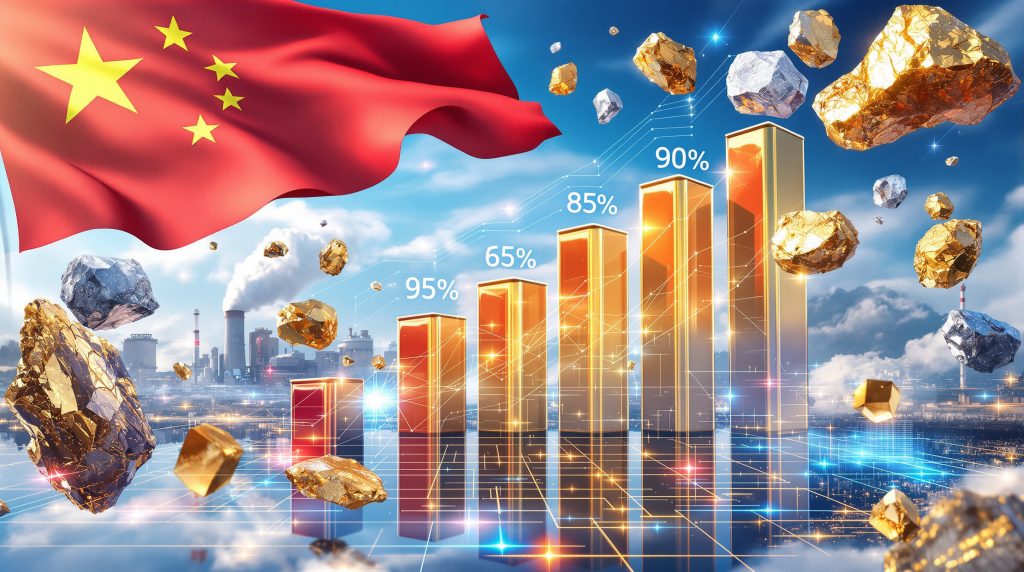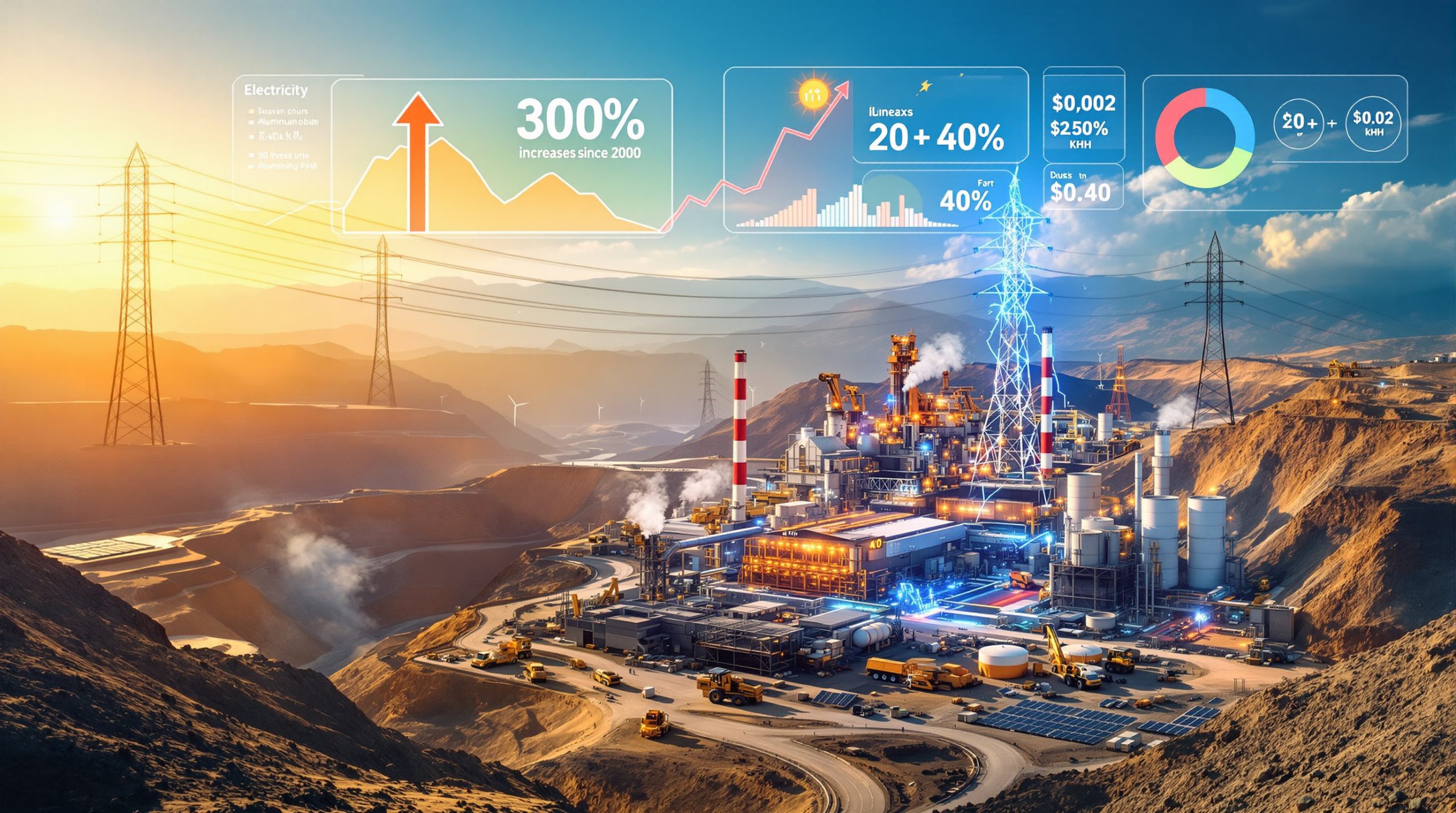China's Strategic Control Over Critical Mineral Supply Chains
China's mineral export controls represent far more than traditional trade restrictions. These comprehensive licensing systems govern international access to rare earth elements that power modern defense systems, electric vehicles, and semiconductor manufacturing. With approximately 90% control over global rare earth separation capacity, China has transformed raw material processing into strategic leverage that extends well beyond its borders.
The framework encompasses twelve specific rare earth elements, including recently added materials like holmium, erbium, and europium. However, the true strategic impact lies not in the volume of materials controlled, but in China's dominance of midstream processing capabilities that convert raw ores into battery-grade compounds essential for high-tech manufacturing.
Understanding the Processing Bottleneck
China's strategic advantage stems from vertical integration across multiple value chain stages rather than simple resource extraction. This integration creates chokepoints that affect downstream industries more significantly than upstream mining constraints. The concentration of separation and purification technologies, developed over decades, represents a technical moat that competitors struggle to replicate.
Key processing capabilities controlled by China include:
- Hydrometallurgical separation requiring specialised expertise
- Solvent extraction processes for individual rare earth isolation
- Environmental management systems for radioactive byproduct handling
- Quality control infrastructure producing ultra-pure compounds
The Scale of Strategic Dependency
| Material Category | China's Market Share | Critical Applications |
|---|---|---|
| Rare Earth Separation | ~90% | Defence electronics, permanent magnets |
| Gallium Processing | ~95% | Semiconductor fabrication, military radar |
| Heavy Rare Earths | ~85% | High-performance motors, wind turbines |
| Magnet Manufacturing | ~85% | Electric vehicles, aerospace systems |
The United States imports approximately $170 million in rare earth materials annually, with $120 million sourcing directly from China. This represents 70% of America's rare earth compounds despite constituting only 3% of total critical mineral imports by volume. This paradox illustrates how traditional trade statistics mask strategic vulnerabilities concentrated in processed materials rather than raw commodities.
How Export Licensing Controls Function in Practice
China's 2025 export control framework operates through mandatory government licensing for twelve specific rare earth elements. Applications undergo case-by-case evaluation considering end-use destinations, strategic implications, and national security assessments defined by Chinese authorities.
Regulatory Mechanics and Compliance Requirements
The licensing system requires exporters to obtain Ministry of Commerce approval for each shipment, with processing timelines ranging from 30-60 days for standard applications. Expedited review reduces this to 14-21 days with additional documentation, though approval rates vary significantly based on destination countries and perceived military applications.
Materials requiring licensing include:
- Scandium (Sc) – Aerospace alloys, fuel cells
- Yttrium (Y) – Laser systems, phosphors
- Lanthanum (La) – Battery electrodes, catalysts
- Cerium (Ce) – Polishing compounds, catalysts
- Praseodymium (Pr) – Permanent magnets, aircraft engines
- Neodymium (Nd) – High-strength magnets, hard drives
- Samarium (Sm) – Precision guidance systems
- Europium (Eu) – Red phosphors, security inks
- Terbium (Tb) – Green phosphors, magnetostrictive alloys
- Dysprosium (Dy) – High-temperature magnets, data storage
- Holmium (Ho) – Medical lasers, magnetic flux concentrators
- Erbium (Er) – Fiber optic amplifiers, nuclear control rods
Extraterritorial Enforcement Mechanisms
China's mineral export controls extend beyond traditional border enforcement through de minimis thresholds that capture products containing as little as 0.1% Chinese-origin rare earths by value. This threshold affects an estimated 40-60% of finished electronics products, creating compliance obligations for manufacturers operating outside China.
Re-export restrictions prohibit third-country companies from shipping products incorporating Chinese rare earths to:
- United States defence contractors
- Allied military suppliers
- Sanctioned countries and entities
- Companies listed on China's Foreign Trade Blacklist
Technology transfer controls require licensing compliance from companies using Chinese rare earth processing methodologies, regardless of facility location or material source. This includes proprietary separation techniques, purification processes, and quality control systems developed by Chinese firms.
Economic Impact Analysis: Beyond the Headlines
Macquarie Group's economic modelling estimates that export restrictions on five critical materials could reduce United States GDP by over $1 billion annually. However, this figure captures only direct manufacturing impacts while excluding cascading disruptions across interconnected supply chains.
Breaking Down the Economic Vulnerability
The vulnerability concentration becomes apparent when examining affected industry sectors:
| Industry | Market Value | Dependency Level | Supply Risk |
|---|---|---|---|
| Defence/Aerospace | $800B+ | Critical magnets, targeting systems | Extreme |
| Electric Vehicles | $260B+ | Motor magnets, power electronics | High |
| Semiconductors | $630B+ | Gallium compounds, processing tools | High |
| Renewable Energy | $150B+ | Wind turbine magnets, inverters | High |
The $2 billion in direct critical mineral imports from China supports industries worth hundreds of billions collectively. A single month of terbium shortage can halt fighter jet maintenance programmes, while dysprosium restrictions affect naval radar systems essential for fleet operations.
The Multiplier Effect of Supply Chain Disruptions
Direct material costs represent only the visible portion of economic impact. Production bottlenecks create exponential effects:
- Manufacturing shutdowns when critical components become unavailable
- Inventory adjustments requiring emergency stockpiling at premium prices
- Technology development costs for alternative materials and processes
- Strategic capacity losses in defence and infrastructure systems
Economic modelling suggests indirect impacts could reach 5-10 times the direct material cost increases, though comprehensive assessment remains challenging due to supply chain complexity.
Why Alternative Suppliers Cannot Simply Replace Chinese Materials
While countries like Australia possess substantial rare earth reserves, they lack downstream processing infrastructure necessary to produce market-ready compounds. Furthermore, the critical minerals demand continues rising globally as nations seek to secure supply chains outside China's control.
Raw ore extraction represents only the initial step in complex value chains requiring decades of accumulated expertise and billion-dollar facility investments.
Infrastructure Investment Requirements
| Processing Stage | Capital Investment | Development Timeline |
|---|---|---|
| Separation Facilities | $500M – $1.5B | 5-7 years |
| Metal Refining Plants | $200M – $800M | 3-5 years |
| Magnet Manufacturing | $100M – $500M | 2-4 years |
| Quality Certification | $50M – $200M | 1-3 years |
Technical Knowledge Barriers
Establishing competitive rare earth processing requires specialised capabilities currently concentrated in Chinese facilities:
- Proprietary separation techniques developed through decades of research
- Environmental management systems for handling radioactive thorium and uranium byproducts
- Quality control methodologies producing battery-grade and semiconductor-grade materials
- Process optimisation knowledge maximising yield and purity levels
These technical competencies cannot be easily transferred or replicated, creating natural barriers to supply chain diversification efforts.
Raw Material Processing Complexity
Rare earth processing involves complex chemical procedures that transform mixed rare earth concentrates into individual high-purity compounds:
- Cracking and leaching to dissolve rare earth minerals
- Solvent extraction using proprietary chemical processes
- Precipitation and calcination to produce oxides
- Metal reduction creating pure metallic forms
- Alloy production for specific end-use applications
Each stage requires specialised equipment, chemical inputs, and process control systems that represent significant technical and capital barriers for new market entrants.
Industry Response Strategies to Export Control Risks
Different sectors are implementing varied approaches to mitigate supply chain vulnerabilities, though all face significant technical and economic challenges in reducing Chinese dependencies. Moreover, the development of critical minerals energy security remains paramount for national infrastructure resilience.
Defence Sector Adaptation Approaches
Military contractors are pursuing multiple risk mitigation strategies:
Strategic Stockpiling Programmes:
- Building 6-18 month inventory reserves of critical materials
- Establishing secure storage facilities for high-value compounds
- Developing rotation systems maintaining material quality over extended periods
Supplier Diversification Initiatives:
- Investing in rare earth processing facilities in allied countries
- Funding separation technology development in Australia and Canada
- Establishing long-term contracts with non-Chinese suppliers
Material Recovery and Recycling:
- Extracting rare earths from decommissioned military equipment
- Developing urban mining capabilities for electronic waste
- Creating closed-loop systems reducing virgin material requirements
Technology Industry Risk Management
Semiconductor and electronics manufacturers face unique challenges due to ultra-high purity requirements and just-in-time production systems:
Design Optimisation Strategies:
- Engineering products requiring fewer critical materials
- Substituting less restricted alternatives where technically feasible
- Developing modular designs enabling component flexibility
Vertical Integration Investments:
- Technology companies funding upstream processing capabilities
- Joint ventures with mining companies securing long-term supplies
- Research partnerships developing alternative materials and processes
Regional Production Networks:
- Establishing processing facilities closer to end markets
- Building redundant supply chains across multiple countries
- Creating inventory sharing agreements among industry participants
Geopolitical Dimensions of Mineral Export Controls
China's mineral export controls represent a fundamental shift from economic competition to strategic resource diplomacy, using supply chain dependencies to influence international relations and technology transfer policies.
Strategic Competition in Critical Materials
The export control framework functions as economic statecraft, leveraging China's processing dominance to:
- Influence foreign policy decisions by allied nations dependent on Chinese materials
- Slow military modernisation programmes requiring rare earth-dependent technologies
- Encourage technology sharing through conditional supply arrangements
- Shape industrial development in countries lacking alternative suppliers
This approach represents an evolution in trade policy methodology, extending enforcement mechanisms downstream through global value chains rather than controlling materials solely at extraction points.
Alliance Building and Counter-Strategies
Democratic nations are developing cooperative frameworks addressing supply chain vulnerabilities. For instance, a recent strategic minerals deal demonstrates how nations collaborate to reduce reliance on Chinese processing capabilities.
Minerals Security Partnerships:
- United States-Australia Critical Minerals Alliance focusing on processing infrastructure
- European Union Critical Raw Materials Act establishing strategic reserves
- Japan-India rare earth cooperation agreements diversifying Asian supply chains
Technology Sharing Initiatives:
- Joint research programmes developing alternative separation technologies
- Intellectual property sharing agreements reducing development costs
- Technical training partnerships building processing expertise
Coordinated Investment Programmes:
- Multilateral development bank funding for critical mineral projects
- Government loan guarantees supporting private sector investments
- Tax incentives encouraging domestic processing facility development
Materials Under Strictest Control Measures
China's mineral export controls vary significantly across different rare earth elements, with heavy rare earths facing the most stringent limitations due to their concentrated supply and critical defence applications.
Heavy Rare Earth Elements Face Maximum Restrictions
Terbium and Dysprosium represent the highest-risk materials due to their essential role in high-performance permanent magnets used in:
- Fighter jet engines and control systems
- Naval propulsion and radar systems
- Precision-guided munitions and targeting systems
- Electric vehicle traction motors requiring high-temperature performance
Holmium and Erbium additions to export controls target:
- Medical laser systems and imaging equipment
- Fiber optic communications infrastructure
- Quantum computing research and development
- Nuclear reactor control rod applications
Europium and Ytterbium restrictions affect:
- Security ink and currency authentication systems
- Medical imaging contrast agents and pharmaceuticals
- Laser rangefinding and targeting systems
- High-efficiency lighting and display technologies
Processing Materials and Intermediate Products
Beyond individual rare earth elements, China controls access to processed materials essential for downstream manufacturing:
Gallium Compounds: Ultra-pure gallium arsenide and gallium nitride compounds essential for:
- High-frequency semiconductors used in radar and communications
- Power electronics for electric vehicles and renewable energy
- Light-emitting diodes and laser diode manufacturing
- Integrated circuits for aerospace and defence applications
Refined Rare Earth Oxides: Battery-grade and semiconductor-grade compounds requiring:
- Specialised purification achieving 99.999% purity levels
- Controlled particle size distribution for specific applications
- Trace element control preventing contamination in sensitive uses
- Quality certification meeting military and aerospace standards
Magnet Precursor Materials: Semi-finished products including:
- Neodymium-iron-boron alloy powders for permanent magnet production
- Samarium-cobalt compounds for high-temperature applications
- Dysprosium and terbium additives enhancing magnet performance
- Protective coatings preventing corrosion in harsh environments
Future Evolution of Export Control Systems
China's export controls continue expanding in scope and sophistication, with potential extensions to additional materials and more stringent enforcement mechanisms anticipated over the coming years. Additionally, regions like Greenland critical minerals are gaining strategic importance as alternative sources.
Potential Control Expansion Scenarios
Additional Critical Materials: Future restrictions may encompass:
- Lithium processing chemicals for battery manufacturing
- Cobalt refining capabilities concentrated in Chinese facilities
- Graphite purification essential for battery anodes and nuclear applications
- Tungsten processing critical for defence and industrial applications
Technology and Equipment Controls: Expanded restrictions could include:
- Manufacturing equipment for rare earth processing and separation
- Software and control systems used in critical mineral facilities
- Technical documentation and process knowledge transfer
- Training and consulting services for processing operations
Enhanced Monitoring Systems: Potential developments include:
- Real-time tracking of exported materials through supply chains
- Blockchain-based verification systems for end-use compliance
- Satellite monitoring of facilities using controlled materials
- Financial transaction monitoring for sanctions enforcement
Market Adaptation and Response Patterns
Global markets are adjusting to increased export control risks through several mechanisms. The ongoing development of a European CRM facility represents one such adaptation strategy to reduce dependency on Chinese processing.
Price Volatility Management:
- Long-term contracts incorporating price stability mechanisms
- Financial hedging instruments for material price risk
- Strategic inventory management balancing costs and security
- Supply chain insurance products covering disruption risks
Contract Restructuring Approaches:
- Force majeure clauses addressing regulatory change risks
- Alternative supplier provisions enabling rapid substitution
- Quality specification flexibility accommodating different material sources
- Price adjustment mechanisms reflecting supply constraint impacts
Technology Development Acceleration:
- Alternative material research reducing critical mineral dependencies
- Recycling technology advancement creating secondary supply sources
- Process efficiency improvements maximising available material utilisation
- Substitution strategies developing functionally equivalent alternatives
Business and Investment Implications
Companies and investors must navigate increasingly complex regulatory landscapes while identifying opportunities in alternative supply chain development and processing infrastructure.
Due Diligence Requirements for Businesses
Supply Chain Mapping Obligations:
- Trace rare earth content throughout entire manufacturing processes
- Document Chinese-origin materials at all production stages
- Establish alternative sourcing capabilities for critical components
- Maintain compliance records for regulatory audit requirements
Regulatory Compliance Frameworks:
- Understand both Chinese export controls and domestic import regulations
- Monitor regulatory changes affecting supply chain operations
- Establish legal review processes for cross-border transactions
- Develop contingency procedures for supply disruption scenarios
Risk Assessment and Mitigation:
- Quantify exposure to Chinese-sourced critical materials
- Evaluate alternative suppliers and processing capabilities
- Calculate inventory requirements for operational continuity
- Assess financial impacts of material substitution or shortage scenarios
Investment Opportunities in Alternative Supply Infrastructure
Processing Infrastructure Development:
Facilities outside China for rare earth separation, refining, and metallisation represent significant investment opportunities driven by:
- Government incentives and loan guarantees supporting domestic capacity
- Long-term contracts from defence and technology companies seeking supply security
- Premium pricing for non-Chinese materials in strategic applications
- Export opportunities to allied nations facing similar supply constraints
Recycling and Urban Mining Technologies:
Recovery of rare earths from electronic waste and industrial byproducts offers growing potential through:
- Increasing volumes of electronic devices reaching end-of-life cycles
- Technological advances improving recovery efficiency and economics
- Regulatory requirements mandating material recovery and recycling
- Supply security benefits reducing import dependencies
Alternative Materials and Substitution Research:
Innovation in reduced-dependency designs and alternative materials creates opportunities in:
- Research and development of rare earth-free technologies
- Advanced materials providing equivalent performance with different chemistries
- Manufacturing process improvements reducing critical material requirements
- Intellectual property development in substitution technologies
Investment Consideration: Processing infrastructure investments require substantial capital commitments with multi-year development timelines, but offer potential for significant returns in supply-constrained markets with limited competition from established Chinese facilities.
However, it's important to note that recent developments show some suspension of export restrictions, which could impact investment timelines and market dynamics.
Disclaimer: This analysis contains forward-looking assessments regarding export controls, market developments, and investment opportunities. Actual outcomes may differ significantly from projections due to regulatory changes, technological developments, geopolitical factors, and market conditions. Readers should conduct independent research and consult qualified professionals before making investment or business decisions related to critical minerals and rare earth supply chains.
Looking to Capitalise on Critical Minerals Supply Chain Disruptions?
Discovery Alert's proprietary Discovery IQ model delivers real-time notifications on significant ASX mineral discoveries, enabling investors to identify opportunities in critical minerals exploration ahead of broader market awareness. With China's export controls creating unprecedented demand for alternative rare earth sources, understanding major mineral discoveries and their potential returns becomes essential for positioning ahead of supply chain shifts.




